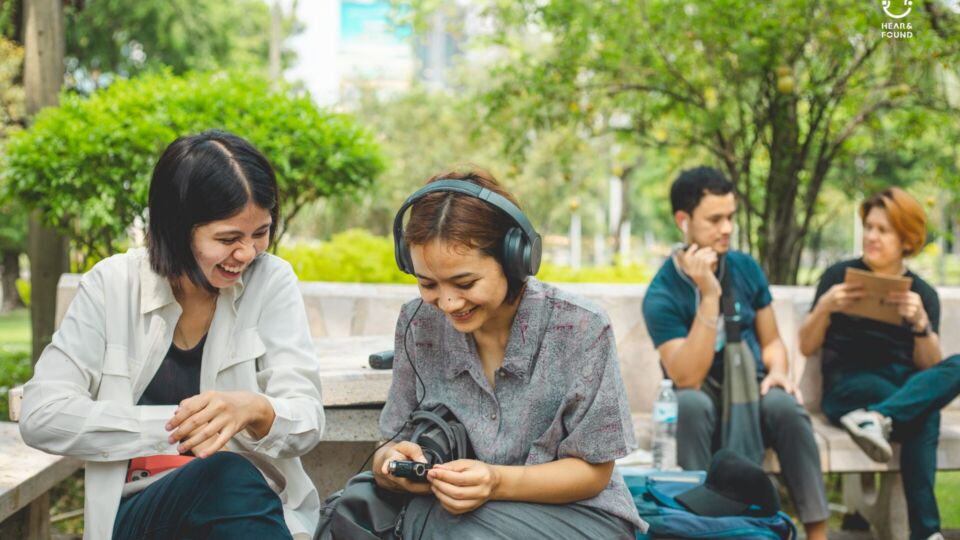Sirasa “Mae” Boonma and Pansita “Rak” Sasirawut started Hear and Found to bring the sounds of Thailand’s countryside alive. More than that, they’re fighting discrimination against indigenous peoples by empowering local musicians to tell their stories in their own way. With more than 200 recordings—as well as the birdsong, running rivers, and natural cacophony of Thailand’s biodiversity—Hear and Found is bringing a unique authenticity to the sound of Thailand. BK’s Tyler Roney speaks with Sirasa Boonma to learn more.
Can you tell us a little bit about how Hear and Found started?
We started five years ago. It started from the idea that we want to preserve cultural knowledge, especially music and wisdom in Thailand. And we see a gap in that the new generation can’t access this. That’s how we started. During this process, we discovered that we are losing our cultural treasures because, especially the city people, we don’t have access and indigenous people are discriminated against…discriminated against their language, their dress. Like mothers weaving clothes by themselves and weaving for their kids, when the kids go to the school, they are bullied because of what they’re wearing…In Thailand, we have around 17 ethnic groups, which is about 7 million people or 1% of the Thai population, which is a huge number. But social media and mass media often talk about the indigenous people in a bad way—that these people are drug dealers or burning forests to cause PM 2.5 smoke. So we want to offer another side to the story for people to recognize and to get to know the indigenous people. We communicate with indigenous people by using music and sound as a tool because music has a special power.
Could you also tell us a little bit about how you work with local artists?
So, usually we go to the village. Me and my partner used to work in community-based tourism or sustainable tourism, so we have a network of local communities. With that, we know where we should go. When we work with the community, we usually start off with one question. What is your objective? That’s the first question that we asked the local community. For example, one of the Karen people, one of the indigenous groups, said that to communicate about himself or the community, he wants people to understand that the Karen people do not burn the forest. They have a reason to do that; they have to grow the rice to eat. That’s the objective. I explore that idea by living with them in their house, seeing how they work in everyday life, eating their food, cooking, and just living with them and learning and listening to their stories. And then we go into design, and by design we mean how can we engage an audience to listen to your songs, to listen to your stories? Sometimes that’s a hard issue. It’s very difficult to understand and to digest. How can we make it simple? Sometimes it can be a music event, exhibitions, or workshop. We did world music events before Covid. We invited them to Bangkok, and we paid the professional rate. Also, they helped us design the lineup of songs and what to talk about.
Photo: Hear and Found / Courtesy
You also do nature recordings, such as bird songs and the sounds of nature. Can you tell us more about that?
With the nature sounds, it comes after COVID. For artists, Covid was tough work. Nature helped us to understand the biodiversity in the area, to understand the context, to understand the space and everything. So we record bird songs, we record rivers, sounds, we record the bamboo forest. It depends on each community, what they have and what they would like us to get into because when we say ‘community’ it’s not just small houses packed together, but a huge forest area. First we go to the community and the houses, but the second time, the community invites us deep into the forest of their home. So it really depends on the relationship and what they have during that season.
How can people support your efforts?
Of course, if you are in Thailand check out our social media, Facebook and Instagram. If you’re in Thailand we might also have exhibitions or events or workshops that you can join, along with audiences from around the world. You can listen to songs and buy songs from our website, and you can support us by buying a license specifically for your media or for your events. We also share this money back with the community and the artist.
Readers can get in touch with Hear and Found to support their work or license their music at hearandfound.com or by getting in touch with them on Facebook or Instagram.
Photo: Hear and Found / Courtesy
This story originally appeared in BK Magazine.




